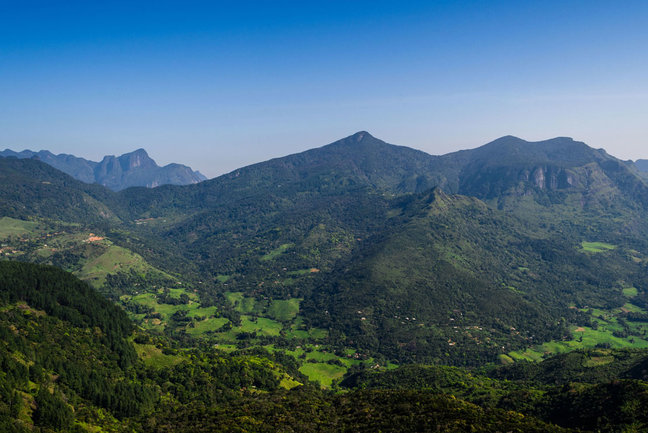Please enter your username and password to logon to the member pages

Off the beaten track
Off the beaten track Overview
Off the beaten track in Sri Lanka Experience the traditional lifestyles of the rural paddy farmers, coastal fisherman, tea pluckers of the central hills and Sri Lanka’s indigenous inhabitants: the Veddas or Wanniya-laeto (forest-dwellers).The Veddas preserve a direct line of descent from the islands’ original Neolithic community dating from at least 16,000 BC.
Learn of their age-old rituals, share meals with the villagers, dance to their rhythms and learn of their livelihoods including crafts that have been passed down through the generations. This journey takes you through remote regions of Sri Lanka away from the main tourist trail and provides a glimpse into the island’s rich cultural heritage; wildlife and nature; and the myriad of beautiful landscapes.
Touring Style - a private tour with your own driver who also acts as your guide.
Day 1: Experience a stay in a rural retreat
Upon arriving in Sri Lanka, transfer to Casa Heliconia, a peaceful holiday retreat immersed in nature just 45 minutes drive from the airport. Explore the surrounding rural village with its village homes, marketplace, and the Buddhist temple just next door. En route, stop by a wayside shop for a drink of king coconut or a slice of pineapple.
Day 2 and 3: Experience Kandy's remote villages and ancient cultural heritage
Head to Sri Lanka's hill capital - the small lakeside city of Kandy. Visit the sacred Temple of the Tooth where a sacred tooth relic of the Lord Buddha is enshrined. Religious services (pooja), accompanied with traditional drumming, are held at the temple daily at dawn, midday, and in the evening.
Continue on for another 45 minutes northeast of Kandy to the rural village of Narampanawa and check into the Samadhi Centre – a tranquil holiday retreat set amidst 20 acres of wilderness edge by the Hulu Ganga (river).
Explore the surrounding Kandyan village and en route, break journey at the river below for a refreshing river bath. Taste Sri Lankan rice and curries cooked in clay pots over a hearth. Samadhi is a nature lover’s dream with ample trails where numerous species of birds can be spotted.
You are also welcome to use any of the pavilions scattered around the gardens for yoga or meditation.
Day 4 and 5: Trek in the magnificent Knuckles Conservation Range
Rise early and journey into the breathtaking Knuckles Conservation Range. You will be taking the northern route into the Knuckles via Digana, Hunnasigirya, and Kobonilla. Once at the village of Karambaketiya, check into Corbet’s Rest, a guesthouse with cottages hugging the mountainous landscape. The Knuckles mountain range, so called because of its appearance resembles a set of knuckles of a clenched fist, consists of five mountain peaks and several other smaller peaks.
A wide variety of rare and endemic flora and fauna makes this wilderness area a storehouse of rich biodiversity. About 30 species of mammals have been recorded in the Knuckles wilderness. Some of the common species include wild buffalo, wild boar, black-naped hare, jackal, toque macaque & purple-faced leaf monkey, fishing cat, sambar and mouse deer.
Trek through dense forests, along rivers and waterfalls, past tea plantations and terraced paddy fields and visit some of the small rural village communities. Panoramic views of misty mountains, stunning valleys, ancient rock formations, lush forests, crystal clear streams, beautiful animal and plant life, paddy fields, traditional villages and hospitable people make the Knuckles an unmissable and unique blend of nature, culture and adventure.
Day 6 and 7: Visit the secluded villages and Vedda communities
Journey out of the Knuckles Conservation Range and travel further east to the town of Mahiyangana which is steeped in history. This is a memorable journey downhill via 18 hairpin bends in stirring hill-country scenery. Stay two nights at the Far Cry, an eco-friendly holiday retreat set on a 12-acre plantation in the remote village of Wilgamuwaabout half an hour away from the town of Mahiyangana.
Go bird watching or fruit and vegetable picking within the plantation. Take a stroll up to the banks of the scenic Mahaweli River and watch as the villagers go about their daily lives. Take a jeep safari to the jungles of Wasgamuva National Park, home to herds of wild elephants, sloth bear, deer, crocodile and numerous species of birds.
About 30 minutes away is the sacred Mahiyangana temple that has been recorded in the Buddhist scriptures as one of nine locations on the island that Lord Buddha visited thousands of years ago. The temple is visited by pilgrims from across the island and consists of an ancient semi-circle shaped stupa, Bo-tree, statues and murals.
Visit the island’s indigenous inhabitants, the Veddas or Wanniya-laeto (forest-dwellers) in the Maduru Oya National Park. The Veddas preserve a direct line of descent from the islands’ original Neolithic community dating from at least 16,000 BC. The few remaining Vedda communities are determined that their way of life will continue into future generations and still retain much of their distinctive cultural identity, an indigenous language, traditional lifestyles, and occupations including hunting, honey gathering, and Chena cultivation.
Day 8 and 9: Experience the scenic highlands, tea plantations and gushing waterfalls
From Mahiyangana travel south to Ella in the southern highlands via Badulla. You will journey through a remote and scenic region which is scattered with waterways, jungles and mountains.
Situated 3,300 ft. above sea level, Ella is surrounded by mountains, waterfalls and tea covered hills. Trek to Little Adam’s Peak, the ancient Dova Temple, and Ravana caves and Ravana falls associated with the epic Ramayana tales.
Learn about the famous Ceylon Tea and its production with a visit to a nearby tea estate and tea factory. Adisham, a Benedictine Monastery, and several waterfalls including Dunhinda and Diyaluma are also located nearby in Bandarawela and Haputale.
Day 10 to 12: Go surfing or loll on the beach in Arugam Bay
Travel out of the hills and on to the sandy beaches of Arugam Bay in the South East of Sri Lanka. Arugam Bay is famously known as one of ten top surf spots in the world. The relatively isolated beaches and a simple, laid-back lifestyle away from the main tourist haunts have many devotees. The best time for surfing in Arugam Bay is in July and August when the swells are high and the wave breaks are thrilling. Trek to the ancient Kudimbigala Forest Hermitage which is spread over about 4,700 hectares of wilderness. Trek uphill over huge rock boulders, thick forest cover, past ancient meditation caves and temple ruins. Once you reach the peak, visit the small temple and take in the breathtaking views across the Eastern Shore. Explore the jungles of Kumana Bird Sanctuary also known as Yala East National Park. The villus (swamp lakes) of Kumana is nesting sites for water birds. During the nesting season which begins towards June, large colonies of pelicans, spoonbills, herons, painted storks, and egrets can be spotted here. The jungles of Kumana are also home to wild elephants, buffalo and deer. Kumana is edged by the Indian Ocean. Often the endangered marine turtles come ashore to nest here on the secluded beaches. The main entrance to Kumana is located in Okanda which is south of Arugam Bay. Best time to visit is at dawn and late afternoon when the animals are easily spotted. A guide can be hired at the entrance gates.Day 13 and 14: Visit the ancient Buddhist sculptures of Maligavila and Buduruvagala
This morning you will travel back along the A4 route to Koslanda via Wellawaya. En route, visit the ancient Maligavila Buddha statue located about 15 km from Wellawaya. This is the largest freestanding image of Lord Buddha in Sri Lanka and reaches a height of about 14 metres. Dating back to the 7th century BC the statue is carved out of a single block of limestone. A second statue depicting Bodhisattva in princely attire is also located in the same vicinity. Once at Koslanda, check into Living Heritage Koslanda, a tranquil four-bedroom holiday retreat set amidst an 80-acre estate on the fringes of the southern highlands. Much of the estate is untouched wilderness that attracts numerous birds, monkeys, deer and even the occasional elephant. Misty mountain peaks of the southern highlands form a beautiful backdrop to this setting. Explore the surrounding estate and cool off with a dip in the river that edges the property. Trek along the main Koslanda to Wellawaya road to the Diyaluma falls – Sri Lanka’s second highest waterfall. Visit the ancient rock sculptures of Buduruwagala located 5 km south of Wellawaya. The sculptures are said to date back to the 8th century and consist of a grouping of six sculptures including a colossal image of Lord Buddha spanning a height of about 50ftDay 15: See water birds and purple faced leaf monkeys at the Talangama wetlands
After an adventurous journey through remote regions of the island, today you head towards the capital city of Colombo for your final night’s stay at Villa Talangama. Set on a quiet lakeside in the suburbs of Colombo, the villa setting is best described as a 'village in the city' surrounded by paddy fields and the Talangama wetlands – one of the best places near Colombo to see water birds and waders. Over a hundred species of birds have been recorded here. The endemic and critically endangered Purple-faced Leaf Monkey is also found here as well as Water Monitors. Relax and unwind before your journey back home.





